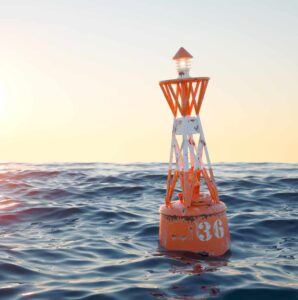Where and how will MCA be used?
In the future, MCA drives will be produced in all sizes: from very small to push light objects (objects that float on water, on-line door-to-door deliveries, in space applications) to very large for propelling large and heavy objects (planes, ships, road vehicles, in-space transport vehicles).
One of the very first two applications may be smart buoys and satellite controls.

Smart buoys:
Currently warning/notification buoys and scientific buoys will remain stationary only as long as they can be anchored to the seafloor. But when the anchor chain is getting longer and heavier (40 meters and more) then the buoyancy of the buoy is not sufficient, and it will sink.
An MCA drive can be installed inside the buoy and will be powered by a solar voltaic charged battery. As the MCA propulsion system has no moving parts inside or outside, the propulsion system will not get clogged-up by seaweed or shell growth.
The buoy is now able to maintain its programmed position almost anywhere in the oceans or even can move around between targets. This will allow the use of expensive science equipment at remote ocean locations that will not be swept away by ocean currents or by wind.
Sattelite Controlls:
The propulsion system from satellites is operational only as long as the on-board fuel lasts. When there is no booster-fuel left then the satellite’s position can no longer be maintained, and it becomes space junk.
Powered by the sun, an MCA drive installed inside the satellite provides propulsion forces for nearly an unlimited time. It is also much lighter as there is no need for booster-fuel.
As the efficiencies and power-ranges of MCA drives will increase, so will the number of applications. Eventually MCA drives will power our cars and land-based transportation system (cars, trucks, buses, trains). At that time the MCA drive will propel, foe example, a suitable passenger cabin on the surface of the earth (maybe inside a large city) and then seamlessly move into space to travel to the moon.
Another use for MCA drives is industrial processing equipment, when levers or larger structures need to change their positions.
When will there be flying cars?
Two things have to happen before we see flying cars:
- The power range of an MCA Drive has to be such that it can not only create thrust for pushing a car forward but also keep it levitated above the ground at some height.
- And the car industry has to be willing and ready for switching from an existing engine type to a completely different engine type.
I am guessing that we are a talking about a time frame of 15 to 30 years before there will be flying cars. On the other hand, a more rapidly changing climate may force us all to implement new technologies much more quickly.
Does MCA and SSP already exist?
Yes, both technologies already exist and work. Besides technology demonstrators we have fully working SSP drives of various sizes. The achieved airspeed at an SSP gas-outlet is user programmable and can be more than 40 km/h.
The MCA technology demonstrators (up to 5 kg) are currently used to drive floating objects inside the TOMO Test Pool or move around in air objects that are suspended inside the TOMO test lab. We are now scaling-up the MCA drive size.
